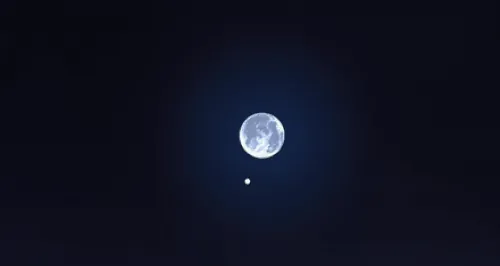
Witness the Spectacular Full Wolf Moon Cover Mars Tonight! Here’s How You Can Experience This Celestial Event!
2025-01-13
Author: Chun
Witness the Spectacular Full Wolf Moon Cover Mars Tonight!
Tonight, January 13, don’t miss the incredible chance to witness a dazzling cosmic showdown! Just days after its enchanting display near the Pleiades star cluster, the Full Wolf Moon will pass directly in front of Mars, which is shining brighter than ever in 2025!
This event is rarer than you might think. For those fortunate enough to be in the right location on Earth, witnessing the moon occult the bright planet Mars happens roughly once every 14 years. So if the skies are clear in your area, mark this occasion in your calendar—it's one you won't want to miss!
Tonight’s Full Wolf Moon, which reaches its peak brightness at 5:27 p.m. EST (2227 GMT), will provide the perfect backdrop as it temporarily obscures Mars, currently just days away from its own official opposition on January 15. The moon and Mars will come close enough for you to see this magical interaction, particularly across much of North America, where enthusiasts have the best seats to this celestial drama.
Why Mars Will Play Second Fiddle Tonight
As Mars glows radiantly at magnitude -1.3—making it nearly as bright as Sirius, the night sky's brightest star—it will be overshadowed by the scintillating brilliance of the moon. The Full Wolf Moon will be nearly 40,000 times brighter than Mars! To truly appreciate this celestial event as Mars disappears behind the moon and eventually reappears, you will need at least a telescope or good binoculars.
But don’t worry, if you’re not equipped for close-ups, just a few hours before or after this cosmic ballet, Mars will be easy to spot with the naked eye, beaming brightly in the evening sky. Many could mistake it for some sort of UFO or drone, causing a flurry of curious inquiries to local radio stations or planetariums as curiosity peaks.
Watch the Enchanting Fade
Unlike the sudden flicker of a distant star, Mars will leisurely vanish behind the moon, thanks to its larger size and proximity. Expect the disappearance to last anywhere from 30 seconds to almost a minute, depending on your view location. For instance, from Washington D.C., you can observe Mars progressively disappearing. It will reemerge just as gradually, giving observers a magnificent show as the moon glides eastward across the sky.
The Optimal Viewing Zone
The visibility zone stretches across the contiguous United States, from Washington State to the eastern shores and even parts of central and eastern Canada. Notably, places such as Port Angeles, Washington, can experience a partial coverage of Mars for about 7 breathtaking minutes starting around 6:27 p.m. Pacific Time.
Conversely, in areas just outside this zone like Vancouver Island, Mars will barely escape the moon's grasp!
Mark Your Calendars! The Next Incredible Event on February 5, 2042
After tonight, don’t forget the upcoming opportunity on February 5, 2042, when Mars will again find itself presenting an occultation for North America while the moon is nearly full.
And remember, Mars's journey through the cosmos means these oppositions aren't uniform—every two years plus some extra days, we experience shifts in distances. This year, on January 15, at precisely 9:31 p.m. EST, Mars is at its closest, making those views truly spectacular.
For cosmic lovers, 2025 might not hold the closest approach of Mars, but we've witnessed some thrilling past events. Do you remember August 27, 2003? Earth barely breezed past Mars, leaving us awe-struck by its brightness—an extraordinary sight many hope to see again!
Prepare your telescopes, grab those binoculars, and treat your eyes tonight. This Full Wolf Moon covering Mars is a treat for stargazers you won't want to miss!



 Brasil (PT)
Brasil (PT)
 Canada (EN)
Canada (EN)
 Chile (ES)
Chile (ES)
 Česko (CS)
Česko (CS)
 대한민국 (KO)
대한민국 (KO)
 España (ES)
España (ES)
 France (FR)
France (FR)
 Hong Kong (EN)
Hong Kong (EN)
 Italia (IT)
Italia (IT)
 日本 (JA)
日本 (JA)
 Magyarország (HU)
Magyarország (HU)
 Norge (NO)
Norge (NO)
 Polska (PL)
Polska (PL)
 Schweiz (DE)
Schweiz (DE)
 Singapore (EN)
Singapore (EN)
 Sverige (SV)
Sverige (SV)
 Suomi (FI)
Suomi (FI)
 Türkiye (TR)
Türkiye (TR)
 الإمارات العربية المتحدة (AR)
الإمارات العربية المتحدة (AR)